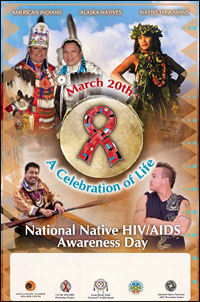
|
Native Americans Demand to Be Included in U.S. HIV Prevention Plans Honoring the 6TH ANNUAL NATIONAL NATIVE HIV/AIDS AWARENESS DAY
On March 20, 2012-the 6th annual National Native HIV/AIDS Awareness Day-American
Indians, Alaska Natives, and Native Hawaiians across the U.S. challenge individuals, health
providers, and government agencies to raise awareness about the impact of HIV in Native
communities. As health departments move forward in implementing the National HIV/AIDS
Strategy released in June 2010 ("the Strategy"), Native American health workers are finding
their communities are being left out of local HIV prevention plans.
 March 17, 2012 - On March 20, 2012 - the 6th annual National Native HIV/AIDS Awareness
Day-American Indians, Alaska Natives, and Native Hawaiians across the U.S. challenge individuals, health
providers, and government agencies to raise awareness about the impact of HIV in Native communities. As
health departments move forward in implementing the National HIV/AIDS Strategy released in June 2010 ("the
Strategy"), Native American health workers are finding their communities are being left out of local HIV
prevention plans. March 17, 2012 - On March 20, 2012 - the 6th annual National Native HIV/AIDS Awareness
Day-American Indians, Alaska Natives, and Native Hawaiians across the U.S. challenge individuals, health
providers, and government agencies to raise awareness about the impact of HIV in Native communities. As
health departments move forward in implementing the National HIV/AIDS Strategy released in June 2010 ("the
Strategy"), Native American health workers are finding their communities are being left out of local HIV
prevention plans.
"The trend across the country is to focus HIV prevention resources on the populations prioritized at the national
level, which doesn't include Native people," said Pamela Jumper-Thurman, a senior research scientist with
Colorado State University's CA7AE project.
The Strategy recommends that our nation's limited HIV treatment and prevention resources be directed toward
the populations most affected by HIV-defined by current epidemiological data as Black Americans, Latinos,
gay and bisexual men, the transgender community, and substance users-and that a greater emphasis be placed
on biomedical prevention models, like "treatment as prevention." Treatment as prevention is based on research
suggesting it may be more effective to lower the likelihood that a person living with HIV can pass on the virus
by keeping their viral loads at very low levels. For the prioritized groups, this is a promising development. But
Native American HIV prevention workers say this new direction is troubling for smaller populations like
American Indians, Alaska Natives, and Native Hawaiians.
"We are the forgotten 1%," said Dr. Jumper-Thurman, referring to the percentage of total HIV/AIDS diagnoses
represented by American Indians and Alaska Natives (CDC, 2009 Surveillance report). "It's unfortunate that
current policies and funding rely on surveillance data that is sadly inaccurate for Native people."
According to the US Centers for Disease Control and Prevention, when population size is taken into account the
rates of HIV/AIDS diagnoses for Native people ranked third in the nation in 2005 (CDC, 2005 Surveillance
report).
Local health departments and government agencies use HIV epidemiological data including HIV prevalence, or
the estimated number of people living with HIV, to identify the populations most affected by the epidemic in
their areas. This data, however, fails to paint a full picture of the disease in smaller populations unlikely to
access HIV treatment or testing services-data from the CDC indicate that over half of American Indians and
Alaska Natives and two-thirds of Native Hawaiians and Pacific Islander have never been tested for HIV. Low
testing rates lead to late-stage diagnoses and increase the chances of unknowingly passing on the disease.
"If our numbers of infection reach what is currently recognized as a priority, it is too late for us," said Harlan
Pruden (co-founder and council member of NorthEast Two-Spirit Society) and Sharon Day (director of
Indigenous Peoples Task Force). "We can no longer be the last in line for funding. Our lives are sacred."
###
About National Native HIV/AIDS Awareness Day
National Native HIV/AIDS Awareness Day (NNHAAD), observed annually on the spring equinox, is a national
community mobilization effort designed to encourage American Indians, Alaska Natives and Native Hawaiians
across the United States and Territorial Areas to get educated, get tested, and get involved in HIV prevention
and treatment. This federally recognized awareness day was founded in 2007 and is funded by the U.S. Centers
for Disease Control and Prevention. Committee partners include Colorado State University's Commitment to
Action for 7th-Generation Awareness & Education (CA7AE), National Native American AIDS Prevention
Center (NNAAPC), Great Plains Tribal Chairmen's Health Board, Inter Tribal Council of Arizona, Inc.
(ITCA), and Asian & Pacific Islander Wellness Center. To find out more, visit www.nnhaad.org or audio PSA,
please visit: http://www.nnhaad.org/pages/mediaKit.html
"Reproduced with permission - National Native HIV/AIDS Awareness Day (NNHAAD)"
National Native HIV/AIDS Awareness Day (NNHAAD)
|